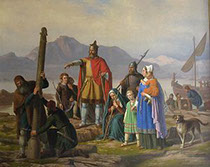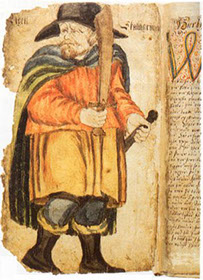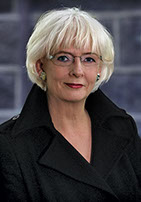A Nordic Nation Establishing its Unique Identity
870s
Ingólfr Arnarson is the first Nordic settler of Iceland and the settlement of Iceland begins.

The Althing is established, to make laws and solve disputes. This was the general assembly for Iceland.
Iceland begins to adopt Christianity. This is when a "golden age" of Icelandic culture begins, with great works of medieval literature.
930
1000

1120
A famous and historical work of literature, the Sagas of Icelanders, is produced in this period. Icelanders have a long tradition of writing literature. In fact, 1 in 10 Icelanders will publish a book in their lifetime.
Manuscript of the Icelandic Sagas, featuring Egill Skallagrímsson. The sagas are now located at the Árni Magnússon Institute in Iceland. (i24).
1230
}
1262
Iceland is incorporated into Norway in that they recognize King of Norway as the monarch.
1380
The kingdoms of Denmark, Norway, and Sweden join a union under the Danish crown.
The Black Death hits Iceland and kills half of the population. Over the next 300 years, Iceland experiences a period of decline due to "disease, famine and a volcanic eruption in 1783 reducing the impoverished population from 50,000 to 35,000."
1402
1783
{
1915
Universal Suffrage is granted: women and workers, irrespective of the taxes they paid, are given the right to vote.
Iceland gets full self- government and sovereign rule under the Danish crown.
The Icelandic National Broadcasting Service A.K.A. Ríkisútvarpið (RÚV) begins radio broadcasting.
The first RÚV television broadcast. Up until 1987, RÚV "blacked out" all broadcasting on Thursdays to promote people going out and engaging in other activities.
The first female president, Vigdís Finnbogadóttir, is elected. She was the first woman in the world to be elected head of state in a national election.
During World War II, Iceland is occupied by British forces and Denmark is occupied by German forces. In 1944, Iceland votes to cut all ties with Denmark and officially become the independent Republic of Iceland.
University of Iceland is established in 1911.
1918
1930
1944
1966
1980
2008
2009
2011
2018
Vilhjalumr gets the first Olympic medal for Iceland in 1956.
{
This is the period in which Iceland suffers a major financial crisis. It culminated with the default of all three of the country's major privately owned commercial banks in late 2008. Previous to that, their difficulties in refinancing their short-term debt and a run on deposits in the Netherlands and the United Kingdom added to the economic stress. "Relative to the size of its economy, Iceland's systemic banking collapse was the largest experienced by any country in economic history." There is much political unrest at this time, as well.
The first female prime minister of Iceland, Johanna Sigurdardottir, is elected. She is also the first openly gay person in the world to be elected head of government.
Iceland qualifies for the FIFA World Cup for the first time.
Iceland's Media Act, which was created to "promote freedom of expression, freedom of information,
media literacy, diversity and pluralism in media and to enhance consumer protection in this
area," is created.

Inspired by the Black Death, The Dance of Death, or Danse Macabre, an allegory on the universality of death, was a common painting motif in the late medieval period. (i26).
Flag of Norway. (i25).
Logo for The Icelandic National Broadcasting Service A.K.A. Ríkisútvarpið (RÚV). (i27).


.jpg?crc=3845520196)

A photo of Vigdís Finnbogadóttir in 1985. (i28).
A photo of Johanna Sigurdardottir.(i29).
*Several sources were cross referenced in making this timeline: o26 - o34.
